Contents
The coniferous mushroom, in addition to the official name, is known as the Old Man or Goblin. The fungus belongs to the Boletovye family, a small genus Shishkogryb. Rarely found in nature, the endangered species is listed in the Red Book.

Description
The appearance is so unattractive that inexperienced mushroom pickers pass by, mistaking the fruiting bodies for poisonous ones. The cone mushroom (pictured) is completely covered with gray or dark brown scales. The color darkens with time, the coating is formed in the form of separating convex seals. Young specimens outwardly resemble a cone of a coniferous tree, and the bristly covering of the leg is gray flakes, hence the flaky-legged cone mushroom got its name.
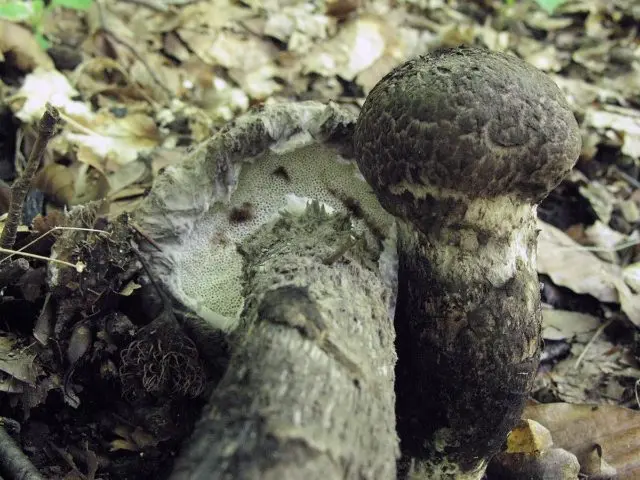
Cap Description
The shape changes during the growing season, in newly appeared specimens it is spherical, fixed to the leg with a veil. Then the veil breaks, the shape of the cap takes on a convex appearance, after 2-4 days it becomes flat. By this time, the cone mushroom is entering the stage of biological aging and is of no value in gastronomic terms.
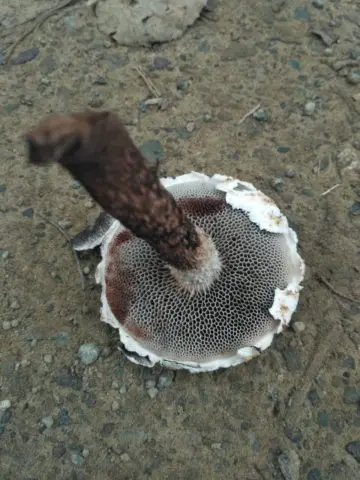
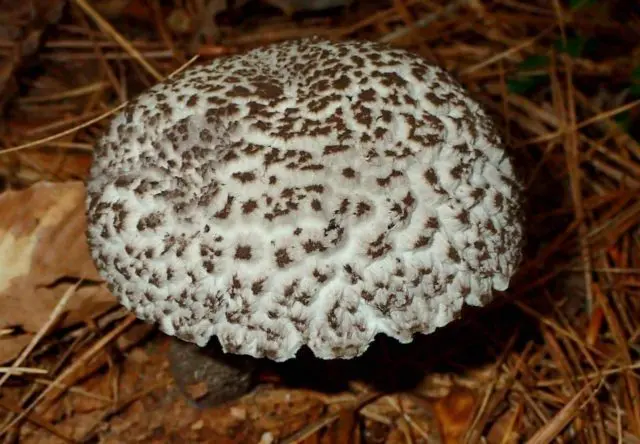
External characteristic:
- Fruiting bodies are large, in some individuals the caps grow up to 13-15 cm in diameter. The surface is white with convex seals in the form of brown or dark gray scales of various shapes and sizes. The edges are uneven with torn fragments.
- The lower part is tubular, porous, the cells are angular. Young specimens are distinguished by a white hymenophore, adults are dark brown or black.
- The pulp is tasteless and odorless. On the cut, during oxidation, it turns bright orange, after a few hours it becomes an inky hue.
- The spores are presented as a black powder.
Description of the leg
The form is cylindrical, expanded at the base, upright or slightly curved.
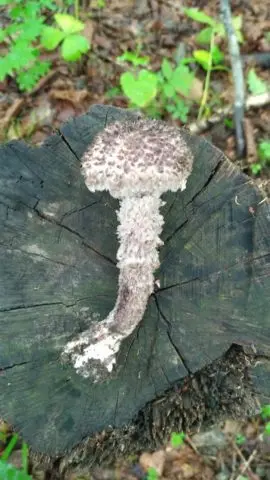
The color is the same as the hat. Length – 10-13 cm. The surface is hard, fibrous. The leg is covered with bristly large flakes. The trace of the ring is clearly expressed in the upper part. The structure is hollow, by biological ripeness the fibers become rigid, so the legs are not used for processing.
Edible coniferous mushroom or not
There are no toxins in the chemical composition of the fruiting body. In Europe and America, Shishkogrib is included in the menu of individual restaurants and cafes. In Our Country, Shishkogryb flaccidum for the absence of smell and unexpressed taste is defined in the category of conditionally edible mushrooms. Only young specimens or hats are processed. In old cones mushrooms, the cap is dry, and the stem remains stiff even when hot processed.
How to cook
The cottonseed cone mushroom is universal in processing. Fruiting bodies can be used for cooking and preparations for the winter. Mushrooms are fried, stewed, boiled, dried. There is no bitterness in the taste, there are no toxic compounds in the composition, so there is no need for pre-soaking.
The crop is cleaned from the remnants of soil, grass and leaves, hard legs are cut off, washed with hot water. Dip in salted water, add citric acid, leave for 15-20 minutes. If there are insects in the fruiting body, they will leave it. The fruits are cut into arbitrary pieces and processed.
How to salt
Salted mushrooms do not differ in taste from species with high nutritional value: milk mushrooms, mushrooms, oil. A simple recipe for salting Shishkogrib flaky-legged is designed for 1 kg of fruiting bodies, for cooking you will need salt (50 g) and spices to taste. Salting algorithm:
- The washed fruits are dried so that no liquid remains.
- Prepare containers. If these are glass jars, they are poured with boiling water, wooden or enameled dishes are cleaned with baking soda, washed well and treated with boiling water.
- Blackcurrant or cherry leaves are placed at the bottom.
- Top with a layer of cone mushrooms, sprinkle with salt.
- Add pepper and dill seeds.
- Sprinkle in layers, cover with leaves on top and add bay leaf.
- Cover with a cotton napkin or gauze, put a load on top.
Put the workpiece in a cool place, after a few days the juice will appear, which should completely cover the fruiting bodies.
How to pickle
Only hats are marinated (regardless of the age of the mushroom). For the recipe take:
- Cone mushroom – 1 kg;
- bay leaf – 2 pcs .;
- sugar – 1 st. l .;
- vinegar – 2,5 tbsp. l. (preferably 6%);
- citric acid – ¼ tsp;
- salt – 0,5 Art. l .;
- water – 0,5 l.
Mushrooms, sugar, bay leaf, salt, citric acid are placed in water, boiled for 20 minutes. During this time, banks are sterilized. Vinegar is added 5 minutes before readiness. The boiling mass is laid out in containers and rolled up with lids.
Where and how to grow
The fungus grows in regions with a cold climate. The distribution area of u2bu3bShishkogryb flaky-legged is the Urals, the Far East, Siberia. Can be found in the Moscow region. Grows singly, rarely XNUMX-XNUMX copies in mixed forests with a predominance of coniferous trees. Settles on acidic soils in lowlands or on hills.

It bears fruit from mid-summer until frost. Rarely seen, Shishkogryb is an endangered species of fungus. The development of industry affects the gas content of the air; in polluted environmental conditions, the fungus does not grow. Deforestation, fires and soil compaction contribute to the extinction of the species. These negative factors have almost completely destroyed the population of the species, so the flaky-legged cone mushroom is listed in the Red Book and is protected by law.
Twins and their differences
There are no false twins in Shishkogrib flaky-legged. Outwardly similar to Strobilomyces confusus.
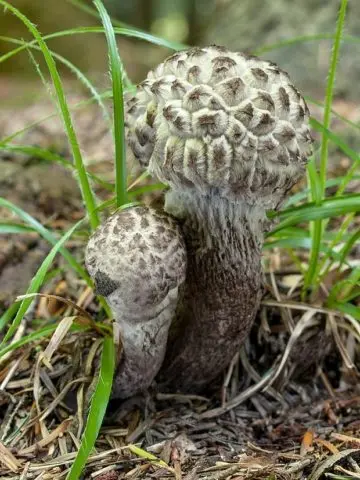
The twin is characterized by identical nutritional value, and also belongs to a rare species. The time of appearance and place of growth are the same for them. In Strobilomyces confusus, the scales on the cap are larger, they clearly protrude above the surface. The lower tubular part is distinguished by smaller cells.
Conclusion
The cone mushroom is an endangered species. Grows in northern regions and partly in temperate climates. Mushrooms are harvested from mid-summer to late autumn. Fruiting bodies do not have a pronounced taste and smell, they are universal in use, they are used for cooking: they are salted, marinated, dried.









